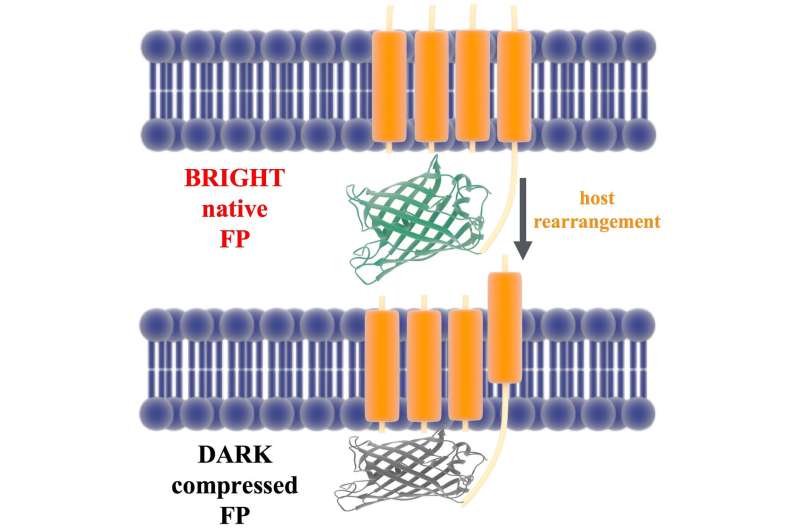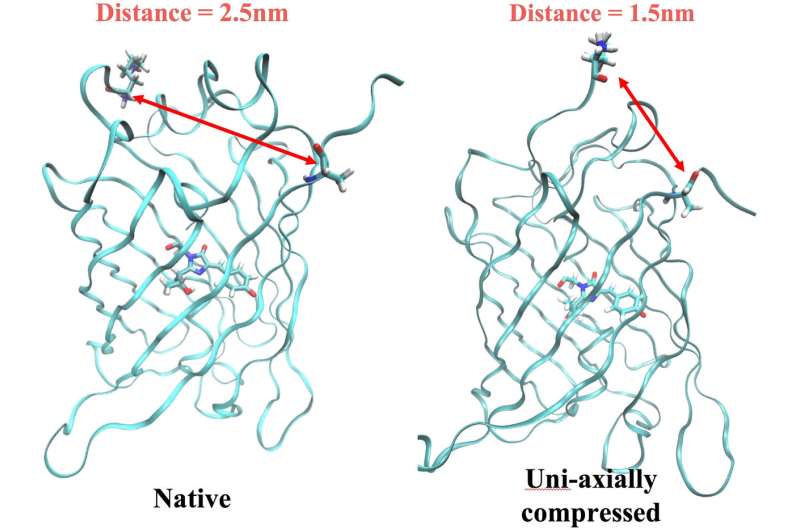Scientists develop method to test fluorescent biosensors before they're synthesized

Rice University scientists have effectively quenched a debate over the mechanism behind a fluorescent biosensor that monitors neurons by sensing changes in voltage.
The work led by Rice theoretical chemist Peter Rossky and postdoctoral researcher Lena Simine confirmed through computer simulations their theory that a mechanical process controls the quenching of fluorescence in ArcLight, a synthetic voltage indicator placed within proteins that line the inner membranes of neurons.
Through their models, the researchers coupled both the mechanism and fluorescence to the strength of electric fields they observed across the chromophore, the fluorescing part of the protein. Their results showed a simple measure of the field in a simulation could be used to predict whether and how well new fluorescent sensors will behave before researchers synthesize them, Rossky said.
The study appears in the Journal of the American Chemical Society.
ArcLight, developed by Yale neuroscientist Vincent Pieribone in 2012, is a genetically encoded fluorescence voltage indicator protein. It contains a mutation that makes the fluorescence signal dim when voltage rises and brighten when voltage falls. That makes it useful for tracking signals in the nervous system by expressing the protein in neurons and seeing how they light up.
The protein is tethered to the neuron's cell wall by a voltage-sensing component that moves a few angstroms when a signal from another neuron changes the electrical charge in the membrane. The Rice researchers theorized that motion pulls the protein against the membrane, compressing it and quenching fluorescence.
Rossky said changing the shape of the protein brings two residues a nanometer closer to each other. That's enough to dictate how the chromophore gets rid of energy, either as light (by giving up photons and fluorescing) or as heat.
"We hypothesized what geometry change occurs in the protein as a result of the response of the membrane," Rossky said. "And then we asked, 'Does this change the fluorescence?' And we found that it does. In addition, we showed that monitoring a much simpler quality—the electric field along two axes where the fluorescence comes from—is sufficient to completely describe the response."

ArcLight proved to be a good model. Pieribone, a Rice collaborator, told attendees at a 2014 lecture at Rice that even he didn't know exactly how it worked. The lecture inspired Simine, who had just come to Rice, to embark upon a study of the mechanism.
"I thought, 'That sounds like a good project for me,'" she said.
Working with researchers in the group of José Onuchic at Rice's Center for Theoretical Biological Physics (CTBP) allowed Simine, a chemical physicist by training, to take advantage of the center's expertise in simulating proteins for testing.
She said a decadelong debate between scientists failed to determine whether mechanical or electrical properties of proteins caused their fluorescence. It turned out to be a bit of both.
"A recent paper gave computational evidence for it being predominantly electrostatic, and it kind of makes sense because the protein's very soft," Simine said. "We also figured those mutations are sticking to the membrane, and when they do, the protein's orientation allows the protein to be compressed." She found electrostatic changes to the neuronal membrane triggered the physical change that quenches fluorescence, but also left an electrical trace in the protein that could be observed in the simulation.
"We put some thought into it and came up with a reaction coordinate," she said. "We can take any mutation of the sequence of this protein and translate it into two numbers that are the inputs for this model, the electrostatic fields around the chromophore. It's a nice, elegant phenomenological theory."
The lab plans to test its technique on custom-synthesized fluorescent proteins and matching simulations to see if their theory and experimentation continue to align. If they do, they expect their models will be highly useful to synthetic biologists making new classes of fluorescent markers.
"If you want to know the fluorescence from a given molecule, you do the experiment," Rossky said. "But if you want to know why it works, these calculations are incredibly valuable."
More information: Lena Simine et al. Fluorescent Proteins Detect Host Structural Rearrangements via Electrostatic Mechanism, Journal of the American Chemical Society (2018). DOI: 10.1021/jacs.7b10851
Journal information: Journal of the American Chemical Society
Provided by Rice University




















